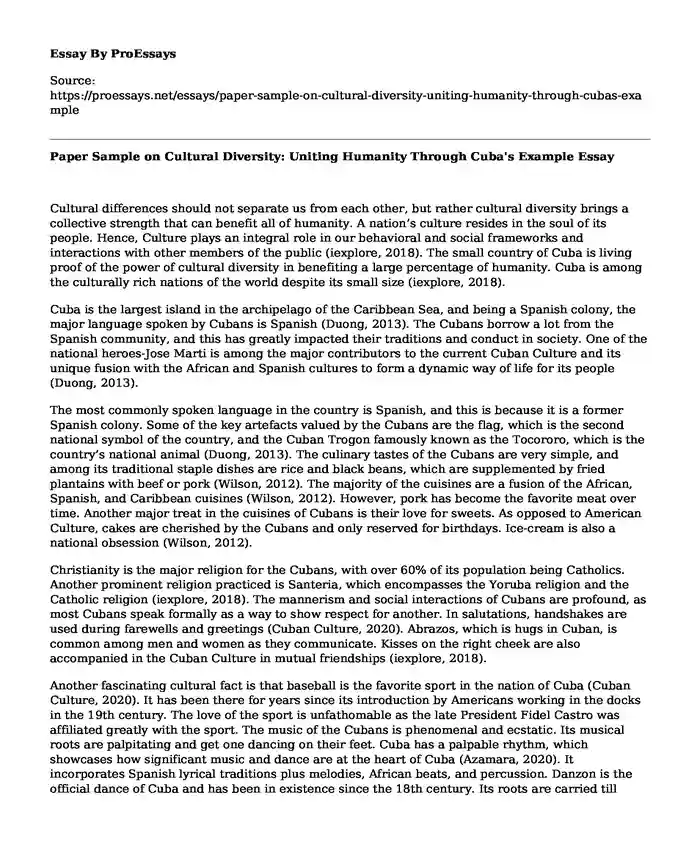Cultural differences should not separate us from each other, but rather cultural diversity brings a collective strength that can benefit all of humanity. A nation’s culture resides in the soul of its people. Hence, Culture plays an integral role in our behavioral and social frameworks and interactions with other members of the public (iexplore, 2018). The small country of Cuba is living proof of the power of cultural diversity in benefiting a large percentage of humanity. Cuba is among the culturally rich nations of the world despite its small size (iexplore, 2018).
Cuba is the largest island in the archipelago of the Caribbean Sea, and being a Spanish colony, the major language spoken by Cubans is Spanish (Duong, 2013). The Cubans borrow a lot from the Spanish community, and this has greatly impacted their traditions and conduct in society. One of the national heroes-Jose Marti is among the major contributors to the current Cuban Culture and its unique fusion with the African and Spanish cultures to form a dynamic way of life for its people (Duong, 2013).
The most commonly spoken language in the country is Spanish, and this is because it is a former Spanish colony. Some of the key artefacts valued by the Cubans are the flag, which is the second national symbol of the country, and the Cuban Trogon famously known as the Tocororo, which is the country’s national animal (Duong, 2013). The culinary tastes of the Cubans are very simple, and among its traditional staple dishes are rice and black beans, which are supplemented by fried plantains with beef or pork (Wilson, 2012). The majority of the cuisines are a fusion of the African, Spanish, and Caribbean cuisines (Wilson, 2012). However, pork has become the favorite meat over time. Another major treat in the cuisines of Cubans is their love for sweets. As opposed to American Culture, cakes are cherished by the Cubans and only reserved for birthdays. Ice-cream is also a national obsession (Wilson, 2012).
Christianity is the major religion for the Cubans, with over 60% of its population being Catholics. Another prominent religion practiced is Santeria, which encompasses the Yoruba religion and the Catholic religion (iexplore, 2018). The mannerism and social interactions of Cubans are profound, as most Cubans speak formally as a way to show respect for another. In salutations, handshakes are used during farewells and greetings (Cuban Culture, 2020). Abrazos, which is hugs in Cuban, is common among men and women as they communicate. Kisses on the right cheek are also accompanied in the Cuban Culture in mutual friendships (iexplore, 2018).
Another fascinating cultural fact is that baseball is the favorite sport in the nation of Cuba (Cuban Culture, 2020). It has been there for years since its introduction by Americans working in the docks in the 19th century. The love of the sport is unfathomable as the late President Fidel Castro was affiliated greatly with the sport. The music of the Cubans is phenomenal and ecstatic. Its musical roots are palpitating and get one dancing on their feet. Cuba has a palpable rhythm, which showcases how significant music and dance are at the heart of Cuba (Azamara, 2020). It incorporates Spanish lyrical traditions plus melodies, African beats, and percussion. Danzon is the official dance of Cuba and has been in existence since the 18th century. Its roots are carried till today and forever for future generations (Azamara, 2020). Cultural diversity is widely appreciated by natives and become a national heritage for every Cuban in the Caribbean Islands and those living all over the world.
References
Azamara, A. (2020). Everything You Want to Know About Cuban Music and Dance. Azamara. Retrieved 27 July 2020, from https://www.azamara.com/int/blog/everything-you-want-know-about-cuban-music-and-dance-0.
Cuban Culture, C. (2020). Culture of Cuba. Cubanaturetravel.com. Retrieved 27 July 2020, from http://www.cubanaturetravel.com/culture.
Duong, P. (2013). Bloggers Unplugged: Amateur Citizens, Cultural Discourse, and Public Sphere in Cuba. Journal of Latin American Cultural Studies, 22(4), 375-397. https://doi.org/10.1080/13569325.2013.840277
iexplore, i. (2018). Cuba — History, and Culture. Iexplore.com. Retrieved 27 July 2020, from https://www.iexplore.com/articles/travel-guides/caribbean/cuba/history-and-culture.
Wilson, M. (2012). Moral Economies of Food in Cuba. Food, Culture & Society, 15(2), 277-291. https://doi.org/10.2752/175174412x13233545145345
Cite this page
Paper Sample on Cultural Diversity: Uniting Humanity Through Cuba's Example. (2023, Oct 27). Retrieved from https://proessays.net/essays/paper-sample-on-cultural-diversity-uniting-humanity-through-cubas-example
If you are the original author of this essay and no longer wish to have it published on the ProEssays website, please click below to request its removal:
- My Father's Gift
- Culture Identity - Essay Example
- Cultural Differences in Marriage Essay Example
- Research Paper on Diversity of the Contemporary Families
- Essay Example on Cancel Culture: A Double-Edged Sword
- Essay Example on Ancient Bronze 'Sleeping Eros' - Unique Exhibit at NYC Met Art Museum
- Similarities of US & Japanese Families: Divorce, Care for Elderly - Essay Sample







